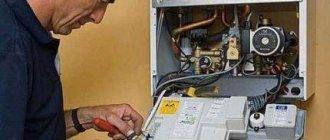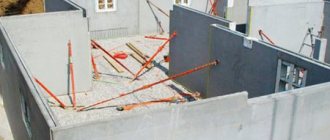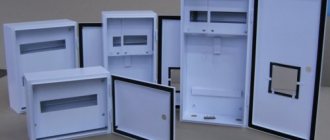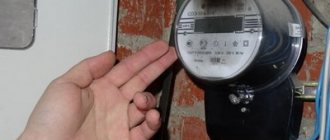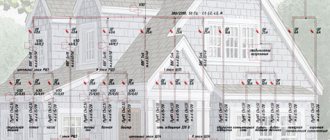Expert author of the article
Olga Ivanovna Avtushko
Leading civil engineer in a construction and installation organization. Work experience - 19 years.
Electricity distribution companies are forcing owners of private houses to install metering panels on the street. The electronic meter on the pole is a cause of disagreement and controversy. Each side pursues its own interests. It is important for suppliers that their energy is not stolen. Consumers are concerned about payments. Advanced technologies, compliance with laws and installation requirements solve the problem.
Why install meters on poles?
For Energosbyt, connecting to the street is beneficial:
- the presence of residents during inspection, control measurements and replacement of faulty equipment is not required;
- there is less chance of electric shock, since the equipment is located in closed panels;
- Pole-mounted electricity meters prevent electricity theft.
The new regulations add further inconvenience to private sector owners.
- When placed outdoors, breakdowns are more likely to occur. Temperature changes, condensation, and solar radiation damage capricious electronics. Wear accelerates. Measurements are distorted.
- Sometimes the installation of an electricity meter on a pole is carried out incorrectly. The standards prohibit the height from exceeding 1.7 m. If the mark is higher, it is difficult to take readings.
- The decision to remove devices is made at a general meeting of the gardening association. The opinion of the individual owner of a country house is not taken into account.
- The electric meter belongs to the owner. Property protection is a citizen's duty. Expensive equipment on a public road is defenseless against intruders.
- In small towns and villages, equipment replacement regularly occurs without the consent of residents. People return from work - “gifts” are displayed on the supports.
Types of electric meters
All electricity meters that are installed to consumers are classified according to the following parameters:
- By connection method;
- By type of measured quantities;
- By type of design.
In apartments and private households, one of the 2 most popular types of electricity meters is now installed, namely:
- Electronic meter – controls consumption at differentiated tariffs (such devices can be monitored from a distance). The popularity of electronic meters is constantly growing.
- Induction meter - measures the electricity consumed by the subscriber using a rotating aluminum disk (this metering device is gradually being forced out of the market, since it is not completely reliable and in some cases allows dishonest subscribers to steal electricity).
Which of the above options is better to install depends both on the characteristics of power consumption by a particular subscriber and on the location of the meter (indoors or outdoors). In this regard, each of the meters has its own advantages and disadvantages.
Electronic meters are becoming increasingly common. The reason for this is their accuracy, as well as ease of use. In addition, if a subscriber wants to take the electricity meter outside, then this can be done with an electronic meter.
When purchasing an electric meter, you should pay attention to the presence of a seal and its integrity (such a seal is installed by the state trustee). Another important point is the timing of the sealing. For a 2-phase meter it should not be more than 2 years, and for a 3-phase meter - 1 year.
Is this legal
The legislation does not prohibit the placement of meters on the street. The procedure is regulated by Government Decree No. 442 of the Russian Federation. The devices are installed at the border between the balance sheet of the supplier's network and the consumer's electrical equipment. If it is technically impossible, the points closest to the line are used.
The property line separates the zones of ownership. During new construction, it is considered legal to secure equipment on metal racks and reinforced concrete supports. For secondary connection it is allowed to use the external wall of the building.
Companies are acting illegally when they force owners to move measuring equipment outside. PUEs do not require the mandatory removal of meters. The instructions in clause 1.5.6 are advisory in nature. The same standards state that dry, accessible places are required for installation. At sub-zero temperatures, devices will need heated shields. A common violation is fastening to the top of a support. The owner has the right not to sign the contract and refuse the procedure if the rules are not followed. It is important that access is kept open.
Regulations regarding the relocation of structures are controversial. In judicial practice, decisions are made both in favor of consumers and in favor of producers. The Federal Antimonopoly Service often supports Energosbyt. The clarifications of the OFAS emphasize that the location of installation of accounting cabinets is the border of the balance sheet.
From July 2021, an intelligent electricity metering program, MIS, will be launched in Russia. “Smart” meters independently measure flow and transmit them remotely to the control server. Subscribers are given a remote control with a screen on which readings are recorded. Now there is no need to force anyone.
Follow the link for more details about the new rules for installing an electricity meter in a private home.
Installation of an incoming panel on a support, standards, rules, tips
First the standards:
According to the PUE (ed. 7), the distance from the floor (ground) to the electric meter terminals should be no more than 1700 mm;
To replace the meter and ensure its safe operation, a switching device or fuses must be installed upstream of the meter. (PUE 1.5.36). By the way, in the same paragraph it is stated that the distance from the switching device to the meter should be no more than 10 meters. That is, if the distance from the support to the house is less than 10 meters, it is possible to install an input panel on the support, and a meter on the facade of the house or in the house.
Related articles: Electrical distribution cabinets ShR and ShRS
Important! Let me draw your attention to the fact that they do not circuit breakers (circuit breakers) before the meter, but a switch or fuses.
Types of meters that can work on the street and the principle of operation
The requirements for outdoor devices are higher than for home ones. External grades are mounted on the supports. When choosing, it is important to consider weather conditions. According to GOST R 53320-2005, electronics must work properly with temperature fluctuations from -25°C to 55°C. Extreme values are -40°С and 70°С. Relative humidity – 95%. Degree of protection – IP54. The characteristics are indicated in the technical data sheet.
The design consists of a housing with a terminal box, transformers or sensors, electronic microcircuits, conversion and transmission units.
Information about current and voltage is sent to the board. The values are transformed into digital codes. Pulse signals are generated at the output with a frequency proportional to the power consumption. Signals are output to the counting mechanism, control LED, transmission device, converter. The result is displayed on the screen.
The following models are installed externally:
- single-phase, three-phase;
- single-tariff, multi-tariff;
- with remote display;
- with sensors or transformers;
- with modem;
- with connection to ASKUE;
- direct, indirect connection.
Scientists have developed a modernized version of pole meters - with a control panel. The calculated measurements are displayed on the display of the remote device.
New counters solve intellectual problems:
- transmission of measurements;
- power limitation;
- event logging;
- setting up a schedule by day of the week;
- tariffication;
- AC sine wave recording;
- disconnecting the load according to specified parameters;
- consumption reading with archiving;
- dispatcher control;
- regulation of display modes.
Each product is assigned an ID number. The indicators are transmitted to the collection center via a cellular communication channel. To work you need WI-FI, SIM card, mobile application. The invoice for payment is automatically sent to your personal account. With regular debt, energy supply is limited.
Types of devices with remote control:
- with or without software;
- with partial or complete shutdown;
- with infrared control or radio control.
By 2023, it is planned to completely replace old equipment with remote-controlled electricity meters.
There is another type of electricity meters with remote control. Their sale and use is illegal.
Base stations - microcells - on poles. What it is?
Many Habr readers began to pay attention to the new equipment on lighting masts.
In general, there are a lot of new boxes on poles, and you are probably wondering what they are. We are installing new microcells. Here is an installation example:
In the photo, from bottom to top:
- Power converter (on the right side of the pole).
- The UMTS base station itself is in a protective box.
- Outdoor base station antenna.
- Radio relay unit for communication with the operator’s platform (outgoing BS channel).
The architecture is standard: the base itself, the transport unit, the power supply. Sometimes an antenna is placed on the top of the pole to improve coverage (as in the photo), but more often the antenna is simply built into the base itself.
Other type of equipment
Here's another pillar. This is not our equipment, but it has already been discussed on Habr (https://habrahabr.ru/qa/27971/), and was identified as a “Device for recording street traffic congestion” installed by the Moscow State Traffic Safety Inspectorate. Such blocks began to appear in parallel with ours, so they are often confused.
This kind of hardware has nothing to do with cellular networks, so I’ll go back to our base stations.
What's inside a microcell?
The base itself when opening the box will look like this:
Here, from right to left, there are the following blocks:
- A digital block that processes traffic and transmits it to the operator’s website (long white boards).
- A power supply that stabilizes and converts external power into the required -48DC (gray block at the bottom of the base).
- Radio unit of the required range, for Russia – 2100 MHz.
- Radio filter for receiving and transmitting signals from an antenna.
Moreover, these blocks are similar to those used in standard base stations, they are simply placed in a compact case, and are designed for low productivity.
For important areas where loss of traffic is unacceptable, batteries can be installed in a unit with a power converter to ensure uninterrupted operation of the base station in the absence of external power for several tens of minutes or hours. However, in general, such batteries are not used, and if the power is lost, the base station will simply turn off. Since the purpose of such stations is to increase network capacity, as a rule, not at peak times, this means that a macro cell located nearby will “pick up” the signal - subscribers will continue to talk, and those who used 3G Internet will feel some speed degradation.
How is this BS different from regular ones?
Small dimensions, and, as a result, less power and capacity.
The typical power of such base stations is 5-10W (37...40 dBm), and for standard base stations it is 20W. The number of sectors in a micro base station is usually one, and a maximum of two carrier frequencies in a given sector. A standard macro base supports 3 sectors and up to 3-6 carriers (depending on the standard) in each sector. It is possible to achieve small dimensions by sacrificing the most important parameter for any equipment providing wireless communication - the coverage radius that such a base creates. If a standard base station can, under ideal conditions, provide a coverage radius of 30 - 35 km, and with the use of additional software options - up to 120 km, then the coverage radius of a microcell does not exceed 1 kilometer, and then only if a good antenna is used.
What are they needed for?
This type of equipment is intended, first of all, to increase the capacity of the mobile network in places where there are local concentrations of subscribers, as well as to improve the quality of communication in places where doing this using conventional bases would be too expensive and not very effective.
That’s why they appear on poles along roads, providing communications to buildings near the road and to motorists bored in traffic jams. Another common option for using such base stations is shopping malls or factories, where the signal from the street is screened by thick walls, and the number of people and the need for communication are very large. My colleague from Kazan will tell you more about this a little later; indoor coverage is a separate big topic.
How did the technology develop?
The need for such small-sized bases was clear from the very beginning of the development of cellular networks, so these solutions have evolved along with the development of the entire industry. The first options for GSM networks were still large and heavy:
Here, both radio transmitters and control units are necessarily combined in one housing. The dimensions of each such base are approximately 1.3 x 0.3 x 0.5 meters, weight 40-50 kg.
Subsequently, the engineers' thoughts focused on dividing the functionality of the base station: the processing unit is allocated to one housing, and the unit responsible for generating the radio signal is placed in another, which is located outside to the antennas. The result is the so-called distributed base stations. These solutions cannot be called micro base stations, but often the equipment that comes across on poles is not a base station, but only a radio module. Here, for example, are RRUs and antennas that are simply set aside from the main blocks of the base station and connected to them with optical fiber:
In the future, the development of this direction will lead to the integration of the transmitter into the antenna, and the emergence of so-called active antenna systems. Many equipment manufacturers are now talking about them, and in the very near future they may appear in operator networks:
However, micro base stations are still solutions in which all units are integrated in one housing, and their development continues towards further miniaturization. They could be like this:
The new devices are only 10 liters in volume and weigh about 10 kilograms. Micro base stations of these new types are now being actively tested, and this year they will appear on the streets of Russian cities.
Practice of use
First-generation microcells are used quite widely in our network, but most often indoors, not on poles, since the bases are still large and heavy.
In the photo with the pillar at the beginning of the topic - RBS3308 of the UMTS standard, it is used in Moscow and in some other large cities quite often. Options for distributed base stations using street transmitters connected to a digital unit via an optical cable have become more widespread. There are a lot of such base stations launched in Moscow and Russia.
A related question - for example, new stations are installed taking into account the “green” technology BTS Power Saving - and these are distributed BSs, where the radio unit is cooled not by the air conditioner in the room or container, but by the ambient air near the antenna. They are used almost everywhere in Russia except for some southern regions - it can still be very hot there outside.
In the future, the number of such base stations will grow steadily; all suppliers are releasing new generations of micro base stations, with smaller dimensions, weight and power consumption. Pilot projects are already underway in the VimpelCom network to launch new types of micro base stations, based on the results of which decisions will be made on the large-scale use of new types of bases in the commercial network. In general, they have proven themselves very well, but we have not yet completed the full testing cycle.
Need a tin foil hat?
The safety of radiation from the base station antenna was analyzed in detail in the topic here. In short, our base station output power is 5-10 W. The radiation pattern is horizontal. At a vertical distance of about a meter it is already completely safe in accordance with strict (compared to Western) SanPiN standards. But I wouldn’t recommend climbing the pole and hugging the sector.
Communication while driving in a car
Since the range of microcells is small (maximum up to a kilometer, typically 200-500 meters), for cars moving at high speed, continuity of service can only be ensured with careful planning and configuration of all environmental parameters.
Seamless interconnection for voice (voice handover) is almost always possible. There is another interesting point. For speeds above 120 km/h, depending on the communication standard, there may be negative effects associated with the transit time of signaling messages in the operator’s network. The Doppler effect has nothing to do with it, but just know that at a speed of 180 kilometers per hour, you will no longer be able to watch streaming video on a 3G network simply because of the physics of the process.
Oh, and what is this strange piece of iron on my pole in front of my house?
If you suddenly find an incomprehensible piece of iron on a pole that cannot be immediately identified, but is presumably telecommunications, please add it in the comments at any time after publication. I am very interested in this topic, so my colleagues and readers will try to understand what it is together.
Why the readings may not match the readings of the home meter
When the metering is taken outside, the home appliance often remains in place. Information from both devices is compared. The owners complain that the electricity meter on the pole is “lying.” The error reaches 10%.
The reason for the discrepancies is a violation of installation standards. Clause 5.1.27 of the Rules requires that devices be operated in dry rooms at a temperature not lower than 0°C. External shields are not sealed. Frost, heat, rain accelerate wear.
Line overload, breaks, short circuits lead to structural damage. Lightning, floods, and accidents on power lines destroy the network.
To appeal bills, you will need to file a statement and call a representative of the energy company. The malfunction is documented.
There is another option - the home electricity meter is lying, not the street one.
Installing an input panel on a support - a legal issue
1. Firstly, the subscriber withdrawal is done with the permission of the energy supply organization and the project approved by it. In such a situation, it is quite possible, on their part, to both prohibit such an installation, and vice versa, to strongly recommend such an installation of the input panel.
This is why you can see entire villages with the same type of installation of input metering and distribution boards on supports near houses, or quite the opposite.
2. Secondly, there are no regulatory documents that would prohibit or even recommend installing input devices with a metering meter on the supports of subscriber taps.
Of course, it is beneficial for administrations at all levels when metering meters are located outside residential premises and are available for control at any time and do not depend on the mood of the owner of the house whether to let the inspector in or not. Such an installation can at least somehow combat the theft of electricity.
Basic installation rules
The accuracy and safety of measurements is affected by proper installation.
- Before starting work, the power line is de-energized.
- The equipment is mounted on a rigid support. The terminals are fixed at a height of 0.8-1.7 m. The branch to the consumer is laid at a level of no lower than 3.5 m above areas where people walk, and no lower than 6 m above the roadway.
- The design of the shield is selected taking into account climatic conditions. Degree of protection – not lower than IP
- Cable descents and ascents are pulled into pipes.
- Metal elements are connected to the ground loop.
- An input circuit breaker is installed to protect against overload.
- After installation, the measuring unit is connected to the network. The diagram is attached.
- At the end of the process, a control run is performed.
- To install electricity meters, an electrical safety clearance group is required.
- The measuring block is sealed. The shield is locked.
Principle of operation
Electric meter with remote reading
An electric meter with remote reading is a device of a special design, placed in the input cabinet or on the pole of the high-voltage line entering the house. With its help, it is possible to organize data recording of consumed energy via the Internet. Software pre-installed in the device allows you to read and send the necessary information to the servers of the energy company responsible for supplying electricity to the consumer.
Using such devices, it is possible to automatically monitor and adjust the accounting process, which significantly affects its efficiency. The principle of operation of a wire meter is easiest to understand if you become familiar with the functionality of the electronic components built into it.
The principle of remote recording of Mercury meter readings
You should start with a microcontroller that performs the following functions:
- processing of credentials;
- bringing the received information to the required form;
- its output to the LCD display;
- receiving and processing control commands.
In addition, the automated accounting system includes a well-functioning interface and a special converter that presents information in digital form. With such technical equipment, the new electricity meters on poles with remote reading are very effective. With their help, it is possible not only to organize data transfer to the electricity supplier, but also to constantly monitor the state of the power grid.
A number of modern models allow you to regulate the level of consumption in a specific sector of the general line. If the permissible value is exceeded, they can automatically stop the metering process by completely disconnecting the meter from the input cable. For these purposes, the control equipment includes a special contactor that blocks the energy supply when the limit is exceeded, or in the absence of prepayment data.
Is it possible to bypass
The theft of electricity causes damage to both the citizen and the state. Lovers of “freebies” hack into panels, install gadgets to stop the count, and are included in the circuit without permission. Attempts to cheat the meter lead to fires, power surges, and damage to household appliances.
The government has introduced amendments to the Code of Administrative Offenses of the Russian Federation. From 2021, a triple fine will be issued for repeated illegal tappings. For the first violation you will have to pay 10-15 thousand rubles. For a repeat – from 15 to 30 thousand rubles. A relapse is fraught with removal from office for 2-3 years. For legal entities the measures are stricter. Failure to pay fines may result in exclusion, a ban on traveling abroad, seizure of property, or court action.
The authorities hope that innovations will stop the mass outrages in the electricity sector.
Thanks to smart mechanisms, conscientious subscribers will not have to pay the bills of offenders. Responsibility will fall on the debtors. New models will help resolve disputes between suppliers and consumers. Useful article? Rate and share with friends!
Features of application
When considering the features of remote meters, it is noted that the energy company is provided with information that is not available with conventional metering devices. Their use is characterized by expanded functionality, allowing the following capabilities to be implemented:
- presentation of information in a multi-tariff format;
- remote control of individual consumers (with the ability to switch them);
- communication with the client by exchanging notifications.
Added to this is the ability to analyze the information provided, which makes it possible to increase the efficiency of the control equipment.
Payment Features
The consumer must pay for the installation of the electricity meter. The cost of installation and connection of an electric meter is from 1 to 5 thousand rubles, depending on the product model. A single-phase, single-tariff device will cost less than an electronic three-phase device, which takes into account indicators for several tariffs.
The owner must resolve the issue of placement of the electricity meter with the resource supplier. The latter does not have the right to force the consumer to move the device outside, but the owner is obliged to ensure unhindered access for employees of the monitoring organization to take readings in the absence of the owner.
You can find out more in the article on the official energy portal: Read more
Advantages and disadvantages
The main advantage is the absence of the need to independently take and transmit readings.
Through the use of devices of this class, it is possible to achieve certain advantages, manifested in the following:
- all disagreements and disputes between the energy supplier and consumer are resolved without much difficulty;
- data stored in the electronic memory of the system can always be presented to the user in documentary form with a printout of consumption by day of the week;
- the permissibility of using different payment tariffs;
- the ability to take readings from devices installed, for example, in a rented apartment.
The accounting principle used allows us to avoid unfair rounding in favor of energy supply companies and unintentional or intentional deception of the consumer.
When installing such devices, it is possible to install them in a home management system called a “smart home”. The use of remote control increases the safety of operation of accounting equipment, since it allows you to do without direct contact with it.
The disadvantages of automatic metering systems include high cost, as well as the need to protect (shield) communication lines from the effects of electromagnetic interference. In addition, when located on street poles, it is necessary to take special measures to protect against precipitation.
Installation procedure
You are allowed to install the meter yourself, but a representative of the resource supplier must connect the device. The work is performed in the following order:
- the input line is de-energized;
- A circuit breaker is installed in front of the device, and an electric meter is connected after it;
- to ensure safe operation of electrical equipment, grounding is installed;
- The home electrical wiring is connected to the output contacts of the product.
When carrying out work, the current regulations must be observed. When the device is mounted and connected, it is subject to sealing and registration.
After installation, a test run is carried out to check that the connection is working properly. Installation and connection are carried out in strict accordance with the requirements of safety regulations.
We recommend: What does it mean to install ODPU in a housing and communal services receipt?
Types of automated devices and electricity metering systems
Electric meter with remote control
When considering this issue, it is possible to find out which types of meters are installed on poles and which are not, and also become familiar with the existing types of devices. One of the options for such devices is an electric meter on a pole with a remote control that allows you to control operating modes, take readings and display them on the built-in display. The range of remote communication is very small and amounts to no more than ten meters.
Another version of this device involves transmitting information to the control panel directly via the power cable (not via the Internet). This method can also be used when installing an electric meter inside an apartment or private house. Some samples of devices for remote readings provide the option of “transferring” information over a radio channel operating over considerable distances. If it needs to be transmitted over short distances, standard infrared communication lines (IRDA) are used.
